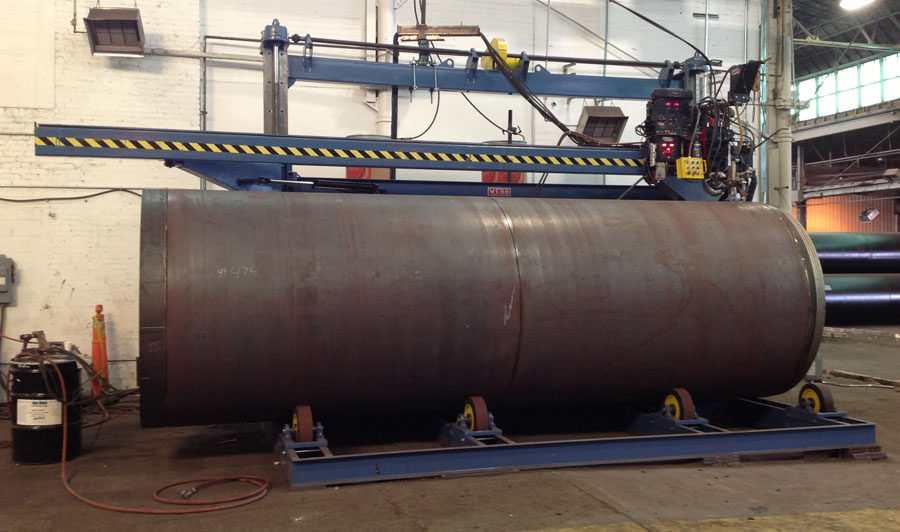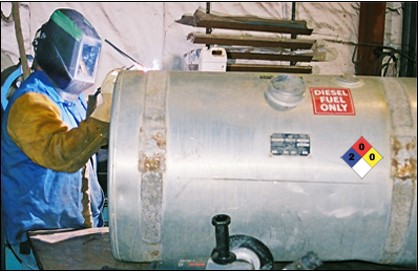Expert Container Welding Assessment Solutions for Quality Assurance and Compliance
In the realm of industrial storage tank building, the honesty of welding plays a crucial function in making sure safety and security, integrity, and longevity. Professional tank welding inspection options stand as the cornerstone of quality control and compliance steps adopted by sectors. From precise evaluations to advanced techniques, the realm of storage tank welding inspection offers an innovative landscape of techniques targeted at promoting requirements and mitigating dangers. However, the value of these options reaches far past plain procedure adherence.
Importance of Tank Welding Assessment
Ensuring the top quality of container welding with meticulous evaluation is essential in preserving structural honesty and avoiding prospective hazards in industrial setups. Tank welding plays a crucial role in different sectors, consisting of oil and gas, production, and chemical processing. The architectural honesty of tanks is critical to avoid leaks, spills, and various other unsafe incidents that can lead to environmental damages, economic losses, and even endanger lives.
With rigorous assessment procedures, welding defects such as cracks, incomplete combination, and porosity can be identified and remedied without delay. Inspections also help guarantee conformity with sector criteria and laws, providing a degree of guarantee pertaining to the top quality and safety of the bonded tanks.
Routine assessments not just improve the general high quality of tank welding but also add to the long life and integrity of commercial tools. By detecting and addressing problems early, business can prevent costly repairs, downtime, and possible mishaps, eventually protecting their operations and reputation.
Advanced Examination Strategies
Carrying out sophisticated modern technologies improves the precision and efficiency of evaluating container welds in industrial setups. One advanced strategy that has actually transformed tank welding examination is using automated ultrasonic testing (AUT) AUT systems utilize robot arms furnished with ultrasonic probes to scan welds quickly and precisely, providing thorough data on weld integrity. This approach removes human error and ensures detailed protection of welds, boosting the overall quality of examinations.
In addition, phased range ultrasonic screening (PAUT) is another sophisticated evaluation strategy gaining popularity in container welding inspections. Tank Welding Inspection Service. PAUT enables precise control over the ultrasonic beam of light angle and centerpiece, enabling examiners to spot and characterize issues with high resolution. This strategy is especially efficient in evaluating complex geometries and can offer detailed imaging of weld flaws for comprehensive analysis
In enhancement to AUT and PAUT, progressed radiographic screening techniques, such as electronic radiography, are being progressively utilized in storage tank welding assessments. These methods supply boosted image quality, decreased evaluation times, and boosted safety compared to conventional radiographic methods. By integrating these innovative examination techniques, industries can ensure better control and compliance with regulative requirements in storage tank welding processes.
Educated Inspection Professionals
Efficiency in evaluation techniques is paramount for guaranteeing the precision and dependability of tank welding inspections in commercial settings. Trained evaluation specialists play an important function in upholding high quality control standards and making certain compliance with regulative needs. These specialists go through strenuous training to establish know-how in various assessment techniques, consisting of visual screening, ultrasonic screening, radiographic testing, and magnetic fragment testing.
Qualified examination professionals are fluent in interpreting criteria and codes particular to tank welding, such as API 653 and API 650. They have the expertise and skills to recognize welding flaws, examine weld high quality, and make educated decisions relating to the acceptability of welded joints. Furthermore, these specialists are trained to operate innovative inspection tools and make use of specialized devices to conduct detailed evaluations of tank welds.
Economical Top Quality Control Solutions

In the middle of the difficulties of preserving high standards in storage tank welding examinations, the pursuit for economical high quality control options emerges as an essential emphasis for industrial operations. One cost-effective solution is the application of innovative inspection innovations such as automated welding assessment systems.
In enhancement to technical improvements, establishing a comprehensive top quality control plan that includes regular inspections, documentation, and staff member training can substantially add to cost savings in the long-term. By spending in training programs for welding examiners and guaranteeing adherence to sector requirements, business can proactively recognize problems, minimize rework, and avoid costly repairs.
Moreover, contracting out specific inspection solutions when needed can be a cost-effective technique for companies that do not have the expertise or sources internal. Working together with reliable assessment companies can offer accessibility to proficient professionals and sophisticated devices without the demand for considerable capital expense. Eventually, focusing on cost-efficient high quality control remedies is important for attaining operational effectiveness, next conference regulatory requirements, and providing high-quality welded containers.
Ensuring Regulatory Conformity


Regulative conformity in tank welding assessments is a basic aspect of guaranteeing market requirements and security requirements are met. Sticking to regulatory guidelines set forth by organizations such as the American Petroleum Institute (API) and Occupational Safety and Health And Wellness Administration (OSHA) is vital to assuring the honesty and integrity of welded tanks. These regulations outline specific criteria for welding treatments, material specifications, evaluation techniques, and high quality control steps that should be complied with to preserve operational excellence and prevent potential threats.
To guarantee regulative compliance in tank welding inspections, certified welding assessors need to possess a detailed understanding of the suitable codes and requirements. Regular audits and analyses must be performed to confirm that welding procedures and procedures align with governing needs. Furthermore, documents and record-keeping are necessary elements of pop over to this web-site compliance, giving a clear trail of adherence to policies for bookkeeping functions.
Final Thought
To conclude, specialist storage tank welding evaluation services play an essential duty in making sure the quality assurance and conformity of storage tanks. By using advanced examination methods and trained experts, companies can effectively monitor the welding procedure, recognize prospective issues, and preserve governing conformity (Tank Welding Inspection Service). This aggressive approach not just aids in protecting against pricey repair work and downtime but additionally makes sure the safety and security and stability of the containers
From meticulous assessments to innovative strategies, the world of container visit this site right here welding assessment provides an advanced landscape of methods aimed at upholding criteria and mitigating threats.Additionally, phased variety ultrasonic screening (PAUT) is an additional sophisticated assessment technique acquiring appeal in tank welding inspections.Efficiency in examination methods is extremely important for making sure the precision and reliability of container welding evaluations in commercial settings. One affordable service is the use of advanced evaluation modern technologies such as automated welding examination systems.In conclusion, professional storage tank welding evaluation options play a vital duty in making certain the top quality control and conformity of tanks.